The $14 MP3 Player disassembled
Posted by Wesley on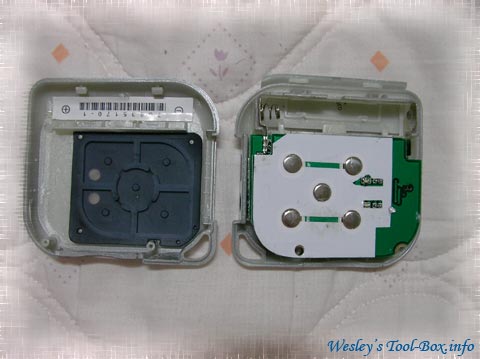
Guts open
(Continuation of "The $14 MP3 Player")
Curious to find out what made this cheap MP3 player tick, I had to take it apart... carefully, of course, because I wanted to keep using it. You unscrew two tiny metal bolts, then have to unhinge the two plastic hooks that stick the top and bottom pieces together. The plastic hooks were a bit hard to get around, since it looked kind of easy to break. I did manage to do it without breaking anything, and the device revealed its innards.
The top part is made up of the plastic casing and the button rubber, while the bottom part has the circuitry and the battery housing. Unlike what I originally expected, the buttons on the circuit were metallic contacts that were pushed in by the rubber 'bumps'.
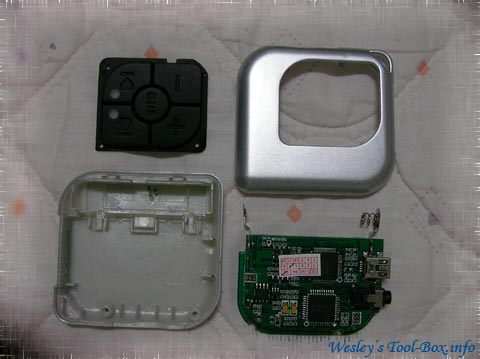
Four major pieces
Here's the look of the four pieces separated completely. Surprisingly little space was wasted in its design.
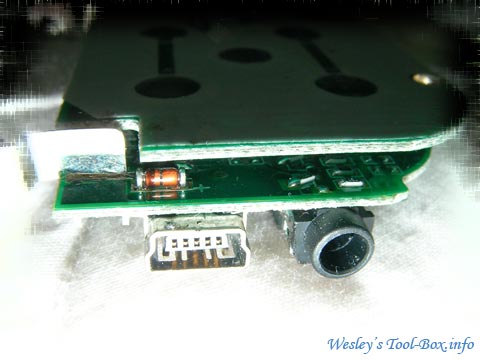
Two-layer design
Limited space was effectively used by sandwiching two circuit boards together. The top part takes care of the button functions while the bottom part does the rest.
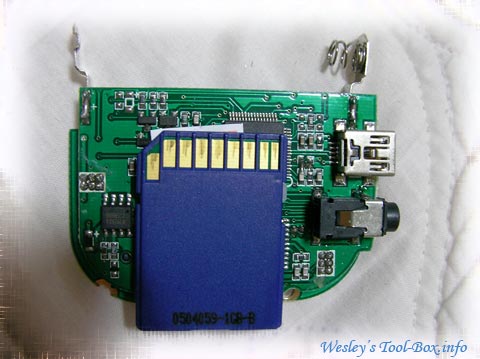
Circuit vs Memory
To put the circuit's size into perspective, here's the picture with the SD card over it. The card slot is located between the two circuit boards, and the card would take up this much space when inserted.
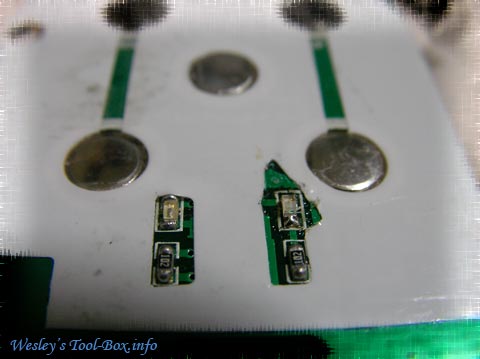
The SMD-type LEDs
The two LEDs are actually SMD type ones that are soldered onto the board next to the buttons. The holes for the LEDs have somewhat shoddy finish, but doesn't affect performance.
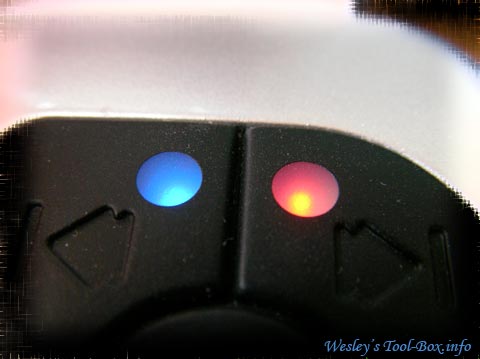
Lights!
Here's how it looks when both of the LEDs light up. The blue one indicates MP3 playback and data transfer, while the red one indicates USB connection and low-power warning.
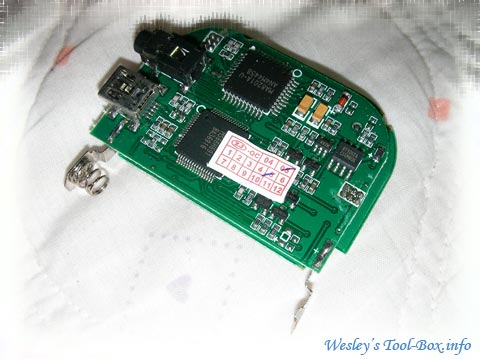
Circuitry close-up
Looking at the circuit revealed some interesting tidbits. The square chip at the top left, next to the earphone jack, is the MA8201A-U MP3 decoder DSP chip from a Taiwanese company called MosArt.
Testing revealed that this chip cannot play 320kbps MP3 files at the right tempo. While the pitch is retained, the song gets stretched over, making the songs slower than intended. The files had to be encoded in 256kbps or less to sound correct. VBR (variable bitrate) MP3 files played fine. Using my own set of earphones, the sound was crisp and had manageable bass tone; there was a small hissing when nothing's being played. Overall, the sound quality was good for the money.
The other square chip located to the bottom is labeled as MS66H691 and while it's listed in some component websites what it exactly does wasn't indicated. However, given the position next to the USB connector, it seems to be the USB mass storage chip that drives the USB connection and the flash memory card.
In file transfer tests, it was confirmed that the chip was indeed running at "Full-Speed" spec with theoretical maximum of 12Mbps (1.5MB/s). Sustained file copy speed to the flash memory card was measured to be around 600KB/s. I think I'll use my usual "Hi-Speed" flash card readers to if I needed to transfer lots of files, which is several times faster.
A smaller chip at the far right is the RT9262A step-up DC/DC converter from RichTek. This powers the MP3 chip from the AAA battery: it has the startup voltage of 1.0V with operating range between 0.8V to 6.5V, and outputs 3.3V, meaning any 1.5V alkaline battery or 1.2V Ni-Cd/Ni-MH rechargeables can be used. By the way, although nominal voltage of Ni-MH battery is 1.2V, fully charged ones have no-load voltage of 1.4V or more.
Battery tests were done with both the bundled alkaline battery and a Sanyo 900mAh Ni-MH rechargeable battery. The bundled one lasted a bit more than 4 hours of total play time. Accurate figures were impossible because I was testing various aspects of the player with it. With the Sanyo rechargeable, the playback lasted 5 hours 40 minutes and the player shut down. Some online shops claimed 5 hours of playback while some claim 8 hours. It looks like some of them got the figure right. In any case the times were unimpressive and falls short of many general MP3 players out there.
One more thing... the playback controls of this player is not very flexible. You have the choice of listening to the previous or next song, or if you press the buttons for a longer time, you can 'rewind' or 'fast forward' through the song. That's about it. There is no 'shuffle' option, although it does recognize directories, so you could group your songs into relevant directories. When you stop it, or if the battery runs out and you start playing it again after replacing the battery, it always starts from the start of the list, not where you left off. This may get frustrating.
In conclusion, it's an interesting toy that might make some use of your memory card, but you should get a 'real' MP3 player if you can.